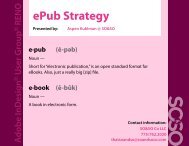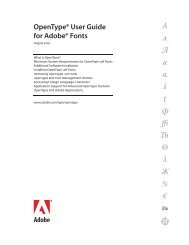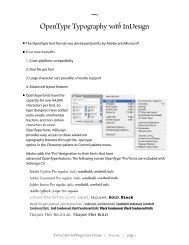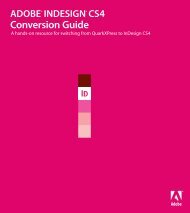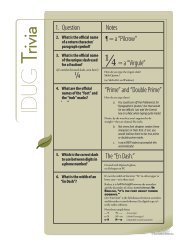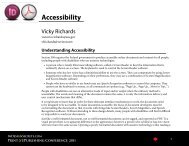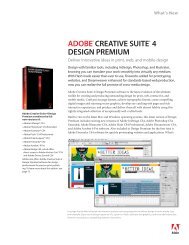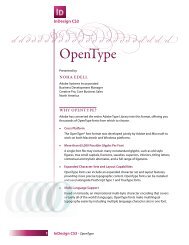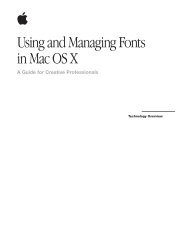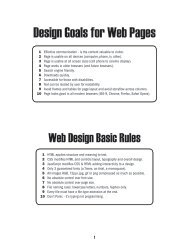Quark to InDesignCS3 Conversion Guide - InDesign User Group
Quark to InDesignCS3 Conversion Guide - InDesign User Group
Quark to InDesignCS3 Conversion Guide - InDesign User Group
You also want an ePaper? Increase the reach of your titles
YUMPU automatically turns print PDFs into web optimized ePapers that Google loves.
how does <strong>InDesign</strong> support XmL?<br />
<strong>InDesign</strong> CS3 offers extensive XML<br />
support. You can import, create,<br />
style, edit, and export XML files<br />
using an integrated <strong>to</strong>olset that<br />
includes a Structure pane for viewing<br />
and managing tagged content, a Tags<br />
panel (Window > Tags) for creating<br />
and applying XML tags <strong>to</strong> content,<br />
easy controls for mapping XML styles<br />
<strong>to</strong> text styles (and vice versa), and<br />
optional use of Document Type<br />
Definition (DTD) files for defining<br />
and validating XML structure.<br />
With this support, you can:<br />
• Apply Extensible Stylesheet<br />
Language Transformation (XSLT)<br />
style sheets when importing or<br />
exporting XML content <strong>to</strong> make it<br />
easier <strong>to</strong> flow XML in<strong>to</strong> <strong>InDesign</strong><br />
page templates or export it <strong>to</strong> a<br />
database or website.<br />
• Bring existing content more easily<br />
in<strong>to</strong> Adobe <strong>InDesign</strong> CS3 by<br />
importing tables tagged with the<br />
82 Adobe <strong>InDesign</strong> CS3 | <strong>Conversion</strong> guide<br />
XML Workflows<br />
To maximize profitability, publishers must find the most efficient ways <strong>to</strong> extract and s<strong>to</strong>re<br />
content in a format that can be reused. For many publishers, the leading choice is XML and XMLbased<br />
workflow au<strong>to</strong>mation. <strong>InDesign</strong> supports these workflows with powerful XML import and<br />
export capabilities, extensive scripting support, and innovative approaches <strong>to</strong> other cross-media<br />
workflows. <strong>InDesign</strong> uses <strong>to</strong>ols, processes, and metaphors you’re already familiar with, plus a few<br />
new ones, <strong>to</strong> help you create, manage, and deliver XML.<br />
CALS standard and converting<br />
them in<strong>to</strong> <strong>InDesign</strong> tables.<br />
• Use scripting <strong>to</strong> create XML rules<br />
<strong>to</strong> au<strong>to</strong>matically generate and format<br />
<strong>InDesign</strong> pages or documents<br />
based on imported XML.<br />
• Import and interactively place<br />
XML content, or au<strong>to</strong>matically<br />
flow XML files in<strong>to</strong> tagged templates.<br />
Versatile import options<br />
in <strong>InDesign</strong> CS3 give you control<br />
over the import process. For<br />
example, you can import only<br />
elements that match the existing<br />
tagged structure in the <strong>InDesign</strong><br />
layout. Anything that doesn’t<br />
match is omitted au<strong>to</strong>matically<br />
on import.<br />
• Create a link <strong>to</strong> an XML file on<br />
import, so that you can easily<br />
update your placed XML content<br />
whenever the source XML content<br />
is updated.<br />
• Au<strong>to</strong>matically format XML on<br />
import by mapping XML tags <strong>to</strong><br />
paragraph and character styles in<br />
your document. Or you can more<br />
easily reuse existing content by<br />
au<strong>to</strong>matically mapping text styles<br />
<strong>to</strong> XML tags and then exporting<br />
the XML content.<br />
• Apply XML tags <strong>to</strong> <strong>InDesign</strong> tables<br />
and table content, and then import<br />
XML content in<strong>to</strong> those tables or<br />
export content from them.<br />
• Set up XML templates using DTD<br />
files, and then validate and correct<br />
imported XML content.<br />
what else should I know about XmL<br />
workflows?<br />
In general, XML-based workflows<br />
involve teams of people—writers,<br />
edi<strong>to</strong>rs, designers, and IT professionals—who<br />
define the process<br />
and build the templates, scripts, and<br />
other support needed. However,<br />
even publishers with more limited





